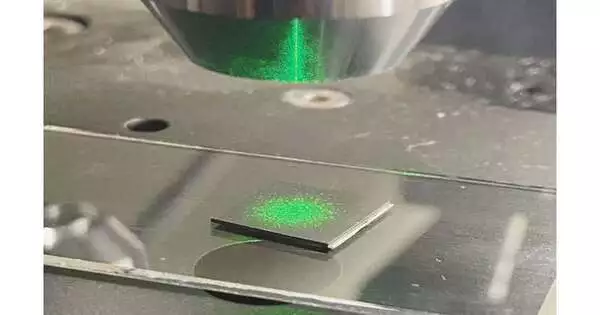Surface-enhanced Raman scattering (or spectroscopy), also known as SERS, is a sophisticated analysis technique that expands the scope of Raman applications to include trace analysis, such as the detection of a pollutant at the part-per-million level in water or other liquids. Biochemistry, forensics, food safety, threat detection, and medical diagnostics are all potential applications for SERS.
However, inexpensive and dependable SERS substrates that permit reproducible spectral signals are still required before the method can be utilized in clinical and industrial settings. By creating a new substrate with plasmonic and photocatalytic nanostructures, material scientists from Kiel University advanced the SERS method. It leads to analyses that are fifty times more powerful than those produced by conventional SERS and improves sensitivity, spatial resolution, and temporal resolution.
The new substrate was designed by researchers to be reusable, resulting in significant cost savings. The journal Small has published their findings.
“Since interactions with laser light impact the Raman signal, the substrate plays the most crucial role in the execution of this analytic approach.”
Josiah Ngenev Shondo. As a doctoral researcher at the Chair for Multicomponent Materials,
The substrate plays a crucial role
Raman spectroscopy, named after physicist and Nobel Prize winner Chandrasekhara Venkata Raman, is a method for determining the chemical composition of materials. The substrate plays a crucial role. As a result, it can also identify hazardous substances. A laser is used to irradiate a material sample for this purpose. In light of the reflected Raman signal, conclusions can be drawn about the properties of the material.
According to Josiah Ngenev Shondo, “the substrate plays the most critical role in the performance of this analytic technique because interactions with the laser light influence the Raman signal.” He works to improve water pollution detection and photocatalytic clean-up as a doctoral researcher at the Chair for Multicomponent Materials.
By combining materials with different properties, the researchers created a novel SERS substrate that increased the Raman signal by 50 times compared to traditional SERS.
Professor Oral Cenk Aktas asserts, “That’s more than has ever been reported before for this method.” This significantly enhances the sensitivity, spatial resolution, and temporal resolution of material analysis at trace amounts. This means that even very small amounts of data can now be analyzed quickly. When the material is investigated, the analysts illuminate the substrate with UV light for actuation and tidy up, individually.
“In this manner, the analyte is broken down, and the substrate, which is quite expensive, can now be used multiple times.” Aktas continues, “We demonstrated that our substrate can be reused at least twenty times without losing its Raman activity.”
Substrate carries SERS approach to an advanced level
The researchers created the novel surface with a composition of nanocolumnar structures, a nanocrack network, nanoscale mixed oxide phases, and nanometallic structures (referred to as “4N-in-1”), taking the SERS approach to a new level. The Raman signal is enhanced, and the surface has a high detection sensitivity. A brand-new variant of the SERS method known as PIERS (Photo-Induced Enhanced Raman Spectroscopy) has recently been proposed.
With their clever Wharfs substrate 4N-in-1,” the exploration group joins plasmonic and photocatalysis ideas to accomplish a high goal and sign upgrade in SERS examination. “Our substrate combines a number of superior properties on a single substrate. According to Dr. Salih Veziroglu, “it is composed of an extremely active titanium dioxide layer in addition to the plasmonic nanostructures.”
Additional plans: “This substrate is the result of many years of long-standing experience and various expertise in our Chair. It is combined with AI methods.” The chair’s head, Professor Franz Faupel, says, “Now we want to transfer our findings from fundamental research into an application.” Any Raman spectroscopy can easily be combined with its substrate, which may lead to new applications.
They are looking for other lab and analytical technology research groups and businesses in order to market their cutting-edge Raman spectroscopy method. They likewise plan to consolidate their strategy with man-made reasoning (simulated intelligence) to make an extensive informational case for materials investigation. This could empower quicker and more exact discoveries of individual atoms.
Shondo has already looked into one idea for a practical application in his doctoral thesis, which is about to be finished. In 2018, the materials researcher came to Kiel College with a grant from the German Scholastic Trade Administration (DAAD) to take care of the natural contamination in his nation of origin, Nigeria. Soils, rivers, and even drinking water are tainted by the country’s vast oil deposits after they are mined.
Shondo and his colleagues have developed a new substrate that could be used in Nigeria with portable Raman spectroscopy equipment. This method could be used at an early stage to prevent worse environmental damage because even small amounts of oil can be detected and even removed.”
More information: Josiah Shondo et al, Nanoscale Synergetic Effects on Ag–TiO2 Hybrid Substrate for Photoinduced Enhanced Raman Spectroscopy (PIERS) with Ultra‐Sensitivity and Reusability, Small (2022). DOI: 10.1002/smll.202270271





